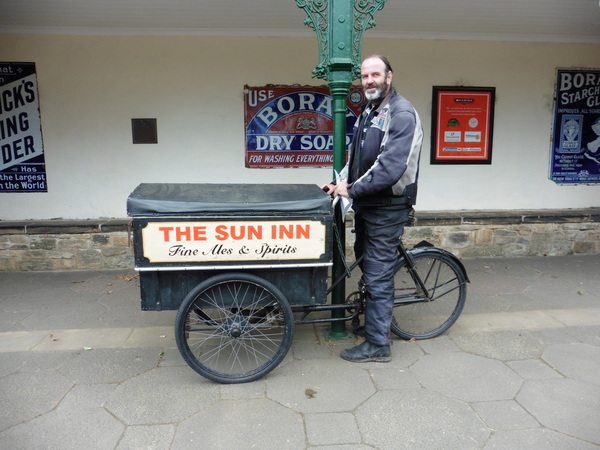Today we took a trip to Beamish the “North of England, Open Air Museum”. Set on 350 acres the Beamish Museum was the brainchild of Frank Atkinson, the director of the Bowes Gallery. It started back in 1958 when he presented a report to Durham County Council with the prospect of opening an open air museum. He was worried that traditional industries and communities were disappearing. His report prompted the collection of everyday items which were stored until the opening of the museum in 1972. The items collected ranged from small pieces to houses, churches and mining equipment.
These days Beamish has developed into various snapshots of Durham’s past with sections representing 1820’s, early 1900’s, and the 1940’s. There’s also ongoing development of the site with new displays being developed.
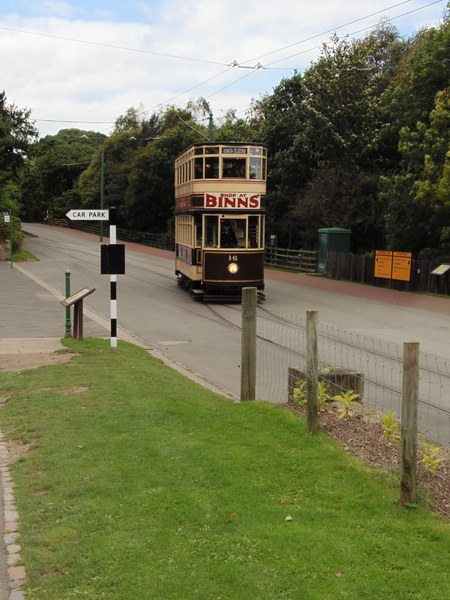
To set the scene vintage double decker trams and vintage style buses run around the whole park.
Pit Village and Colliery
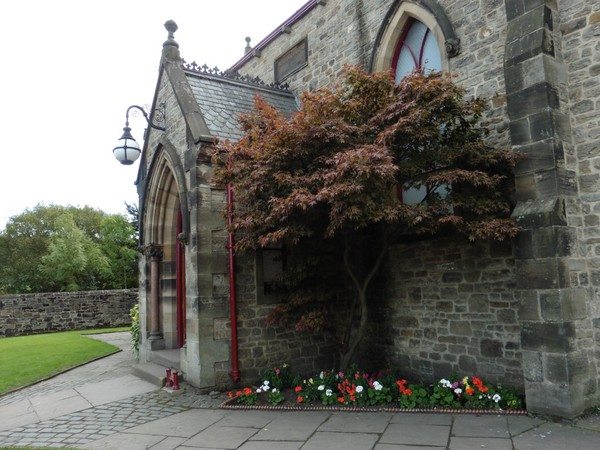
We started our tour by visiting the tradition pit village and colliery. The village is set in the 1900’s with features such as an old church, houses and a fish and chip shop.
The fish and chip shop cooks their fish and chips using the old style method so it takes a little longer but I’m sure it’s worth the wait.
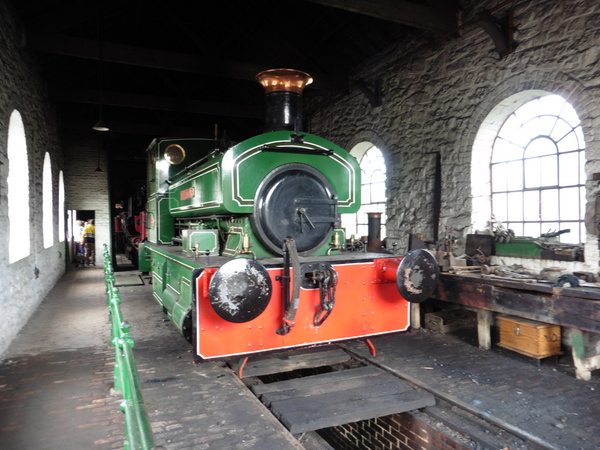
At the old colliery yard there’s a railway shed and train loader. The railway shed has some great old steam locomotives and old style coal wagons. The locomotives are still in working order and we got to view one in action shunting wagons under the loader.
In the old colliery we met up with an old miner who was keen to share some of his stories from “Down Pit!”
He was proud to tell everyone that County Durham still holds the record across whole of Europe, for hand hued coal. In 1913 the record of 41,000 tons was set by Durham using pick and shovel. With 460 mines across Durham, it was the biggest coal field in Europe, employing 2 million miners. Those days are long gone now as there are no mines in operation in the UK, although we remember the coal miners strikes of the 70’s and the 80’s. Many of the former mining towns have struggled with poverty due to lack of jobs. We know what it’s like to have the whole world pulled out from under your feet. Being a miner I’ve been on two mine sites that have suddenly shut down. On both occasions there were no warnings. The whole crew was just called into the office in the middle of a shift to be told the mine is shutting down. Then we were told to go back to your dongas and pack all of your gear because there were buses standing by. The CEO only has a responsibility to faceless investors not to miners families. Pretty ruthless but that’s mining.
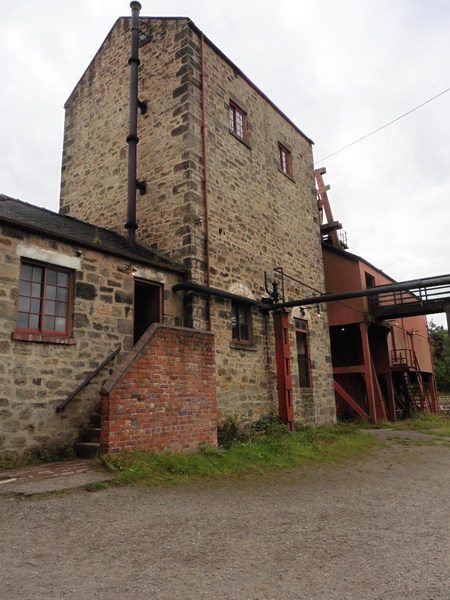
The old miner told us some of his experiences as an underground miner. Starting early in the coal mines he celebrating his 15th birthday by joining the rest of the family underground. He told us a few stories about learning the ropes.
On his first venture underground he was told to purchase some ladies twist tobacco from the store. He was unsure why as he was not a smoker but did so anyway. He quickly learnt working underground the chewing tobacco would keep the mouth wet as there was coal dust in the air. The idea was to spit out the juice as swallowing it would cause heartburn. We also learn that coal miners and their wives when pregnant sucked coal to relieve heartburn. As heartburn tablets were hard to get it actually worked just as well. It was quite an unbelievable fact.
He also told us about life in a mining town. Despite risking their lives underground, miners wages were so low families existed on soup with the only meat being the Sunday roast. The dripping fat from the roast would be used on bread during the week.
The tough life sounded like what the Monty Pythons Yorkshire Miners skit was based on. My grandmother was a product of the Great Depression and she still ate bread and dripping well into her 90’s. I suppose it’s what you get used to.
Pockerley Hall
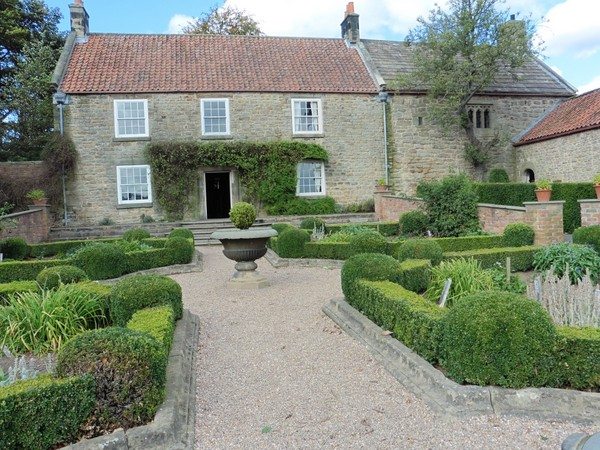
Leaving the Pit Village we wandered through the forest to an area from the 1820’s called Pockerley. It was if the forest was a time machine transporting us back. At Pockerley the Old Hall and farm, sit on top of the hill. The Pockerley Old Hall consists of an 19th century manor house built for a local landowner. It was staffed with people dressed in period costume doing different domestic tasks.
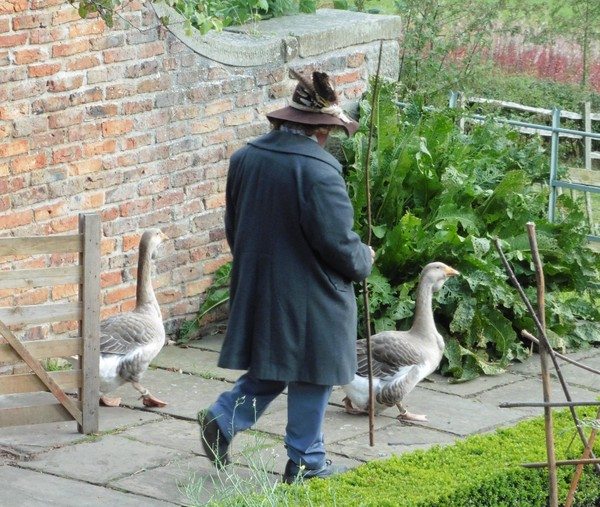
In the yard they were herding geese and in the kitchen they were making jam. The house was quite modest despite being a two storey house. In the upper floor the landowners rooms were large with views over the garden and valley. Meanwhile the servants rooms were tucked under the roof. With cramped conditions, poor light and exposed beams to contend with it mustn’t have been the most comfortable conditions. Also on the upper floor a small smoking room surrounded the chimney. Not a place for gentlemen to retire for a cigar but rather a place especially created to smoke meat. A special flap was opened in the chimney to allow smoke to fill the room and cure the meat. It mustn’t have been much fun going back in to close the flap.
In the downstairs area the rooms are simple but functional reflecting the landowners status.
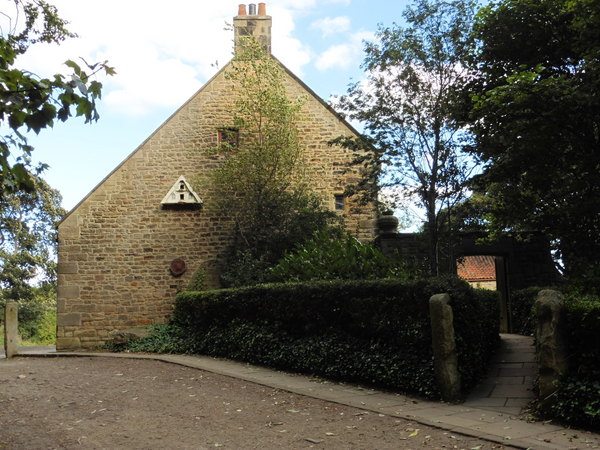
At the end of the building a 13th century tower house is attached. It’s an interesting contrast with the newer building and reflects the turbulent period when the house was built. The interior is quite dark and dingy with the only natural light coming through small slit windows. The house was built with defence as its main purpose. The slit windows are arrow loops and the tower is used as a lookout. The house is basically one room with a fireplace, table and box bed.
Pockerley Hall overlooks the old stone St Helen’s Church which was relocated from a parish whose congregation had diminished.
St Helens Church
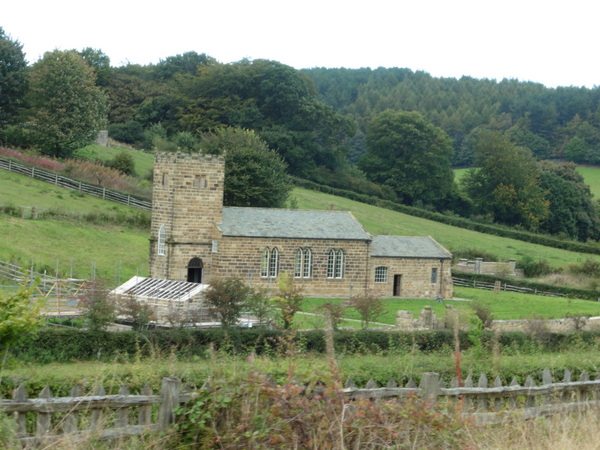
Abandoned in the 1980’s the church was subject to continued vandal attacks. Eventually a decision was made to demolish it. Beamish Museum got involved and simply relocated it to Beamish. It was interesting how they numbered every block of the stone church and simply put it back together using traditional lime mortar.
St Helens Church dates from around 1539 and was probably built over an earlier Norman church. There’s evidence of recycling of materials in the church. On one of the walls is a carved corbel from the original 12th century Norman church. It features a man with a fish in his mouth. In the 1820’s the congregation raised funds to remodel the church into what we see today. With the left over funds they installed lockable box pews. It was a real sign of status to have your own pews.
The church is really quaint and its so wonderful that Beamish could retain this little piece of history to add to the Durham story.
Near the church, staff are currently rebuilding the Hearse House from Marrick Priory. It’s a simple stone shed with a slate roof and arched entry. It was built to house a dray converted to carry coffins. Currently the walls are standing and the roof just has to be fitted. Hopefully if we are back this way we can make use of our one year tickets and visit again.
Steam Elephant
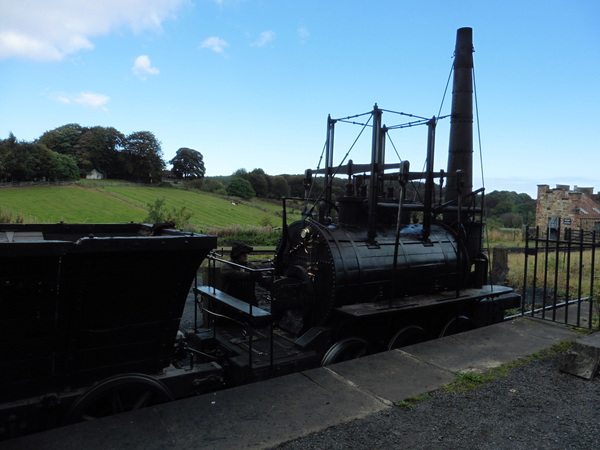
On the opposite hill overlooking the church are the railway buildings which are part of the Pockerley Wagonway. It’s a specially design railway designed to transport coal in the very early era of steam. On the short track a Wallsend Steam Elephant drags a number of carriages at a blistering 4 miles per hour. The Steam Elephant is a replica of one of the earliest steam locomotives used to drag coal wagons. Originally operating on wooden tracks it struggled with traction to drag the 90 tons of coal wagons. Once steel tracks were introduced it worked much better. Beamish recreated the locomotive and have been operating it on the short track ever since. It’s quite unique with six wheels, round boiler and huge stack at one end with the driver and firemen travelling in the carriage behind it.
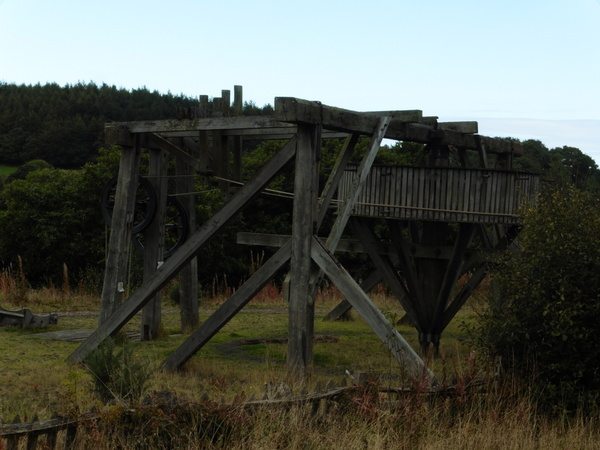
The Steam Elephant runs along the mile track and offers a view of a whim also known as a whim gin or a horse windlass. In small mining operations whims were used to raise material from the mine. A whim consisted of a large wooden drum on a vertical shaft held upright by a tripod. Around the drum, ropes were wound leading to pulleys above the mine shaft. As the drum was turned one bucket was raised and the other lowered. It was a simple operation using a horse to rotate the drum. We’ve seen this type of whims before in our visit to Sweden.
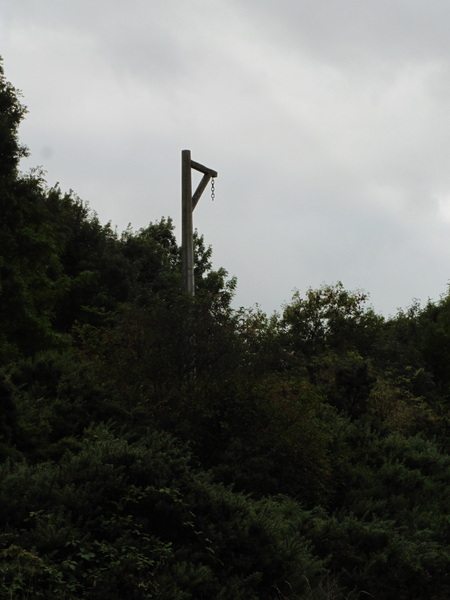
On the crest of the hill above the railway is a gibbet. We learnt that executions were conducted at gallows in the big towns. After the execution the prisoners body was brought back to their village, covered in tar, fitted with a cage and hung from gibbet. The body was hung in the gibbet for five years before the family could petition the house of parliament for return of the body for burial. It was a gruesome reminder to all about the power of the King.
After our short trip on the Steam Elephant we paused to explore the railway sheds where various pieces of railway stock were stored. Around the shed posters of various steam locomotives built by Robert Stephenson, George Stephenson, William Brunton, adorned the walls.
Victorian Town
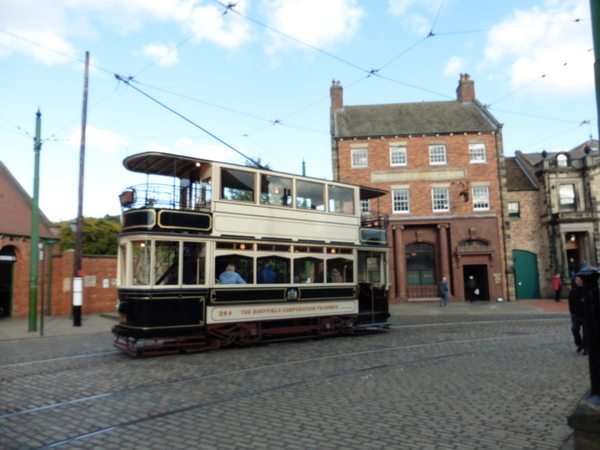
After visiting the 1820’s area we leapt forward one hundred years catching an early 20th century tram to the early 20th century town.
The town with Victorian buildings features various buildings such as carriage works, garage, dress makers, hardware, bakery, sweets shop, dentist, accountant, bank, tea rooms and Masonic lodge. The hardware shop was quite fascinating as it still had a central cashier and a cash ball system. The way the system worked was that cash and a docket was placed inside a ball (about the size of a softball. It was then dispatched to the cashier via a set of tracks. Riding on tracks out of reach of customers the ball rolled along before descending into the cashiers office. Soon it returned rolling along the tracks containing change and the receipt. It reminded me of the vacuum system our hardware shop used to use when I was a small child.
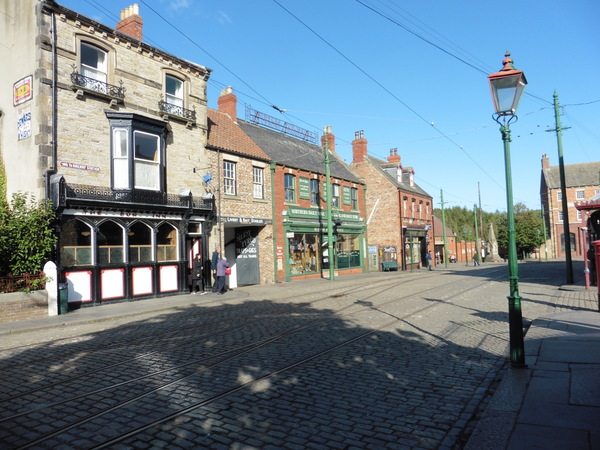
Michele was quite impressed poking around the dressmakers but the garage was more my scene. It had some old motor bikes, motor powered bicycles, and cars. It also had the most curious five wheel postmans bicycle. With a big central Penny type wheel and four smaller Farthing type wheels around it, the Postmans bike must’ve been a hellish contraption to operate.
The Masonic Hall was quite an interesting visit. We met up with a guide who explained some of the basics of the Masonic Lodge. It gave us a real insight into why the Masonic Lodge came into being and it’s importance to local communities.
Around the streets trams, old Bedford and Morris vans and the vintage style bus added to the feel of being back in time.
The carriage workshop was stocked with lots of well maintained carriages of all shapes and sizes. Some types I recognised from my grand uncles barns. There were covered coaches, cabs and a steam traction engine. It was a nice variety. It was also interesting to learn that Beamish hire out the carriages.
At the dentists surgery we learnt how during the Crimean War dead bodies were robbed of teeth to be sold to dentists. Prior to the invention of plastic teeth patients had a choice, ceramic teeth, the teeth of the dead or never eat steak again.
After a late lunch in the tea rooms it was time to call it a day. We’d seen so much of Beamish Museum but there was still so much more to see. We were so glad that the ticket lasts all year so that we can return and look around a bit more.
As we were getting dressed in our bike gear the lady from the cafe came past to wish us good luck. The staff were so nice at Beamish it must be part of that Northern hospitality that everyone talks about. Hopefully the weather will be kind over the next few weeks so we can pop back and enjoy some more of Beamish Museum.
Entry to Beamish is £18.50, the ticket is valid for 12 months so you can return as often as you like. More information is available here
